Several months ago, I attended a watch collectors’ event in London, and over the course of the evening got chatting so someone who was in the process of starting a watch brand. They had an early prototype on hand to look at and try, and I really enjoyed listening to their story of how they had gotten to that point.
The amount of work that had gone into the process, and what had been achieved in the timeframe (at that point only around 12 months from the initial idea and the watch I held in my hand) was staggering, and I was blown away hearing about it.
I was so impressed that as we exchanged contact details, I asked him to let me know when the launch of their first watch approaches, so I could hear the rest of the story – and so he did.
That person was Matt Oosthuizen, the Founder and Managing Director of Apiar.
Apiar launches their first watch – Invenire – on 1st June 2024, and I hope that you find Matt’s story of bringing the brand to life as intriguing and eye-opening as I do.
Starting a watch brand – finding inspiration

Matt Oosthuizen (R) and Sam White (L) of Apiar, photo – Apiar
The story of Apiar begins in 2022. Matt had just been promoted at work, and as many of us do had decided to celebrate that event with a watch. This would be his first “proper” watch (a Tudor for those wondering), and where this might more frequently mark the beginning of that well slipped-on slippery-slope into watch collecting, this journey took a somewhat different turn.
After exploring the world of watches, Matt became fascinated with the creative and design aspects of watchmaking. Working as a Sustaining Manufacturing Engineer, it was around this time that Matt had started working on a project at work which used Additive Manufacturing – an industrial scale process akin to 3D printing.
Whilst similar in principle, Matt explained to me that Additive Manufacturing was the industrial equivalent of the hobbyist 3D printing; where what comes to mind with 3D printing might be relatively small sized machines that you could set up at home and 3D print using plastics, machinery used in Additive Manufacturing are much larger, can cost upwards of £1million and work with metals (in Apiar’s case, this would eventually be titanium).
At the end of the project, Matt found inspiration in the display pieces which were created, with which it was possible to see the lattice shapes within the structures created through the process, which were ultimately incorporated into his watch case designs.
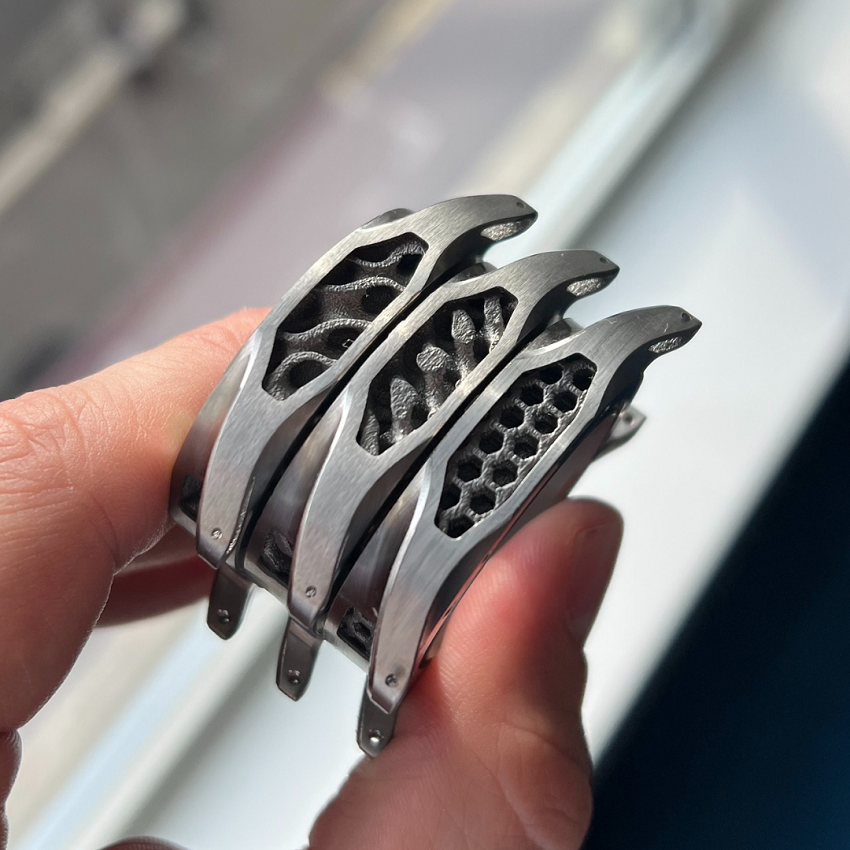
Apiar Invenire Cases, photo – Apiar
Inspiration had struck; where brands might already celebrate use of different materials, Matt’s inner-engineer wanted to create something which celebrated the technological process behind making a watch, specifically Additive Manufacturing, and the idea which went on to become Apiar was born.
Starting a watch brand – building the supply chain
Initially, the idea was to try and create a single watch for himself, and soon after when sharing the idea with childhood friend Sam White, the pair had identified a niche in the market that they both felt passionately about, and so Sam came on board as Co-Founder and Operations Director.
They decided that in wanting to showcase the technology process of Additive Manufacturing, they wanted to offer customisation on the watches. The objective was to do this with a focus on quality, sustainability and British manufacturing, and all the while keeping the cost under £2000.
When speaking with Matt, he explained that when going about setting up the brand, they had two approaches – either taking the “white label” approach or building a supply chain themselves. The pair decided to ensure they had as much control over their objective by building their own supply chain, but obviously in itself presenting a much larger challenge. Building this in the UK would present a bigger challenge, and of course likely be more expensive than other options around the world, but with a desire to celebrate British manufacturing, the pair decided to stay true to their principles from the outset. After all, as Matt put it “you can only launch your first watch once!”
But where to start in building a supply chain? Well, as it turns out, Google!
Building the supply chain, the paid took a real “grassroots” approach when searching for suppliers. Breaking it down, they simply made a list of the different parts/suppliers they needed, and set about researching suitable suppliers online, engaging with them directly and understanding whether their offering was what was needed to get Apiar off the ground. This was quite the challenge, especially when identifying potential suppliers who were UK based, but then learning on engagement that actually the import whatever the part might be, having had it manufactured elsewhere.
Their extensive search ultimately identified the kinds of suppliers they were looking for, such as Bedford Dials, a family business which created their first dial for a steam train 1820 and today manufactures dials and gauges used the automotive industry as well as elsewhere such as in boats and submarines.
Leather straps and travel cases are all crafted from leather supplied by a tannery in Devon. This was itself a bit of a rabbit hole – initially the plan was for the watch boxes to be crafted from British wood, and they even went so far as having prototypes created before changing tack entirely.
Given the vast majority of watch boxes ultimately end up in a cupboard, Matt and Sam decided this wasn’t really in keeping with the pledge for sustainability. Instead, they decided that their watches would be presented in a leather travel case that would be far more likely to be of use to their customers, however as a B2C company they wanted to still provide customers with the much-anticipated unboxing experience. The sustainable solution, avoiding any polystyrene, was a novel material called Mycelium – a mushroom based product which is fully compostable, and provides the same protection in transit as polystyrene would.
Not all suppliers are UK based however, with hands being one area that they chose not to design and instead buy from a French supplier, and re-luming them to match the dials during the assembly process.
Furthermore, the final movements are supplied for Apiar watches are from La Joux-Perret. After initially exploring Sellita and using the SW200, Matt and Sam continued to explore different options and after they discovered La Joux-Perret’s G100 movement, they agreed that it better fit the bill for what they wanted in the first Apiar watch, both preferring the look of the G100 aesthetically, as well as benefitting from a superior 68 hour power reserve.
The star of the show with Apiar was always going to be the cases, with the plan from the outset always being to use this to celebrate Additive Manufacturing, and appeal to the connection between mechanical watchmaking and engineering. However, given what this entails (namely melting powder with lasers in an explosive environment, which has to be filled with argon gas to prevent combustion) it was always going to be a challenge! The pair enlisted the help of Apex Additive, a company who specialise in biomedical and automotive manufacture.
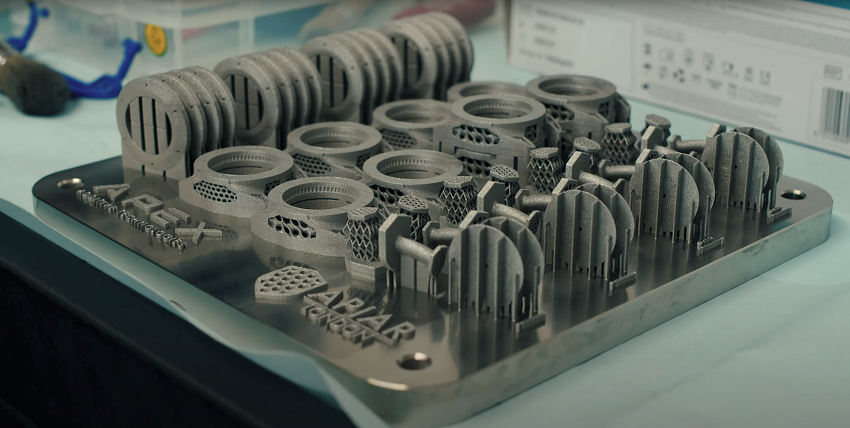
Finished Additive Manufacturing Buildplate, photo – Apiar
Watch cases was a new endeavour, and developing the case was far and away the most time intensive and costly part of this process. The approach was to “fail fast and learn” by printing 5 cases in one go, and getting quick feedback from these as to how to evolve the design. In addition to this there was also the matter of water resistance and designing the case to support this, working within the various standards and regulations, and all the while consideration as to how to champion the technological process of Additive Manufacturing in the right way.
The biggest challenges here were around the lattice structures visible in the casebands and making sure these worked aesthetically, especially within the constraints of the target price. Achieving this even entailed designing the lugs in such as way that you can view the lattice between the lugs. This made the cases harder to polish later, but the priority was to showcase these lattices in the right way.
Interestingly, these lattice structures are also where the name Apiar comes from. Mindful of the Latin word for “bee” being Apis, the lattices resemble the honeycomb structure within a beehive, or apiary, from which the name Apiar is derived.
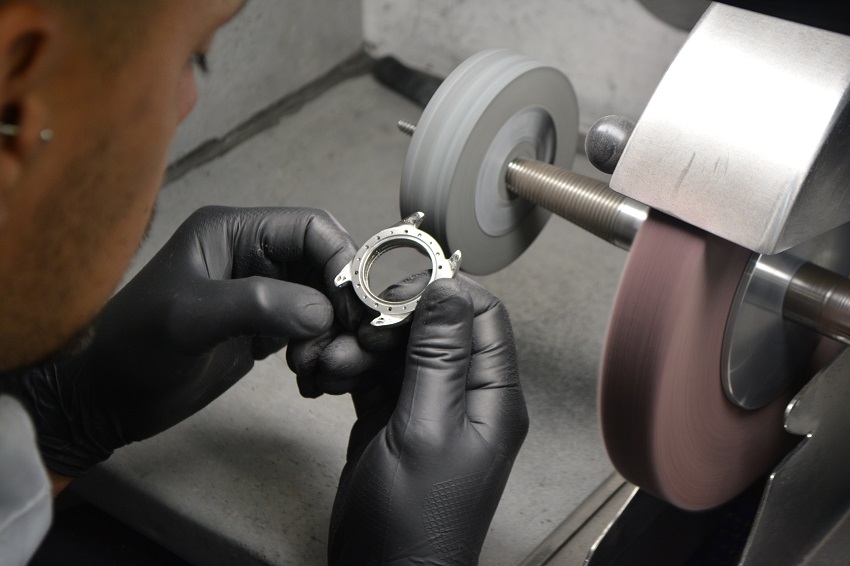
Case polishing in action, photo – Apiar
Matt explained that the biggest learning through all this process, and the one thing they would do differently if they were to start today knowing what they know now, would be to have focused more on the final finish of the case than they did initially – perhaps a case of engineers focusing on the engineering!
With the finish of the case, the journey evolved such that today, the case is manufactured using Additive Manufacturing, before these rough-and-ready cases are further refined (on the outside – the lattices remain in their raw state to champion the Additive Manufacturing process) through using a CNC process to refine the case shape and texture, before they are ultimately hand polished by another new addition to the supply chain based in Newcastle.
Each step in this process effectively represents a “bolt-on” to the case making process and refining the overall product to meet the quality that the pair were striving for, ahead of final assembly (another UK based third party) ahead of having a product that met the standards required for Apiar’s inaugural watch launch.
After going to all this effort, you can see why Matt and Sam decided to make the watch available to the wider public, instead of making a few pieces from themselves, their family and friends!
Starting a watch brand – Introducing Apiar!
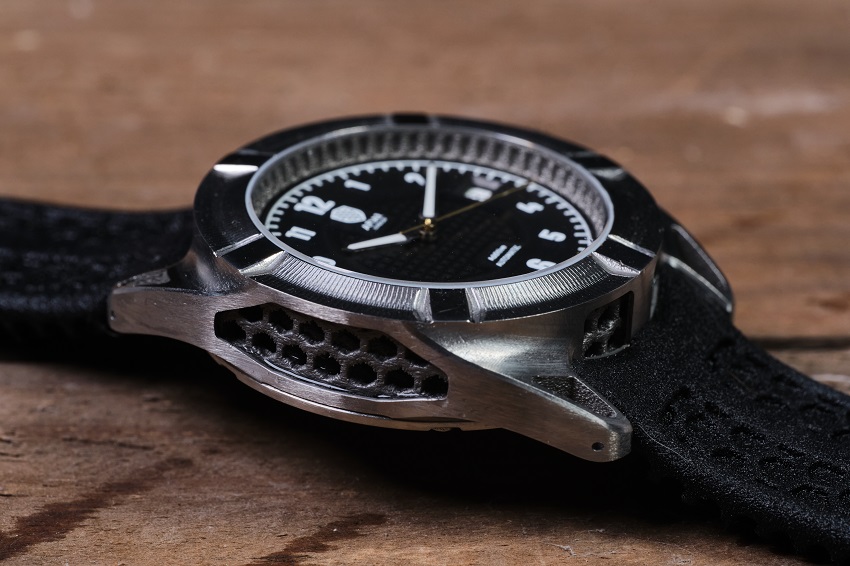
Apia Invenire v1.0, photo – Apiar
It blows my mind that in just two years, whilst all the while working full time in complex engineering roles (Matt is a Sustaining Manufacturing Engineering whilst Sam works in Nuclear Engineering), the seed of an idea has been cultivated and grown into a new brand which counts itself as a new member of Roger W. Smith and Mike France’s ‘British Watch and Clock Makers Alliance’, with a clear message, and a product which is now ready for market launch…
Apiar launch their first watch, the Invenire v1.0, on 1st June 2024!
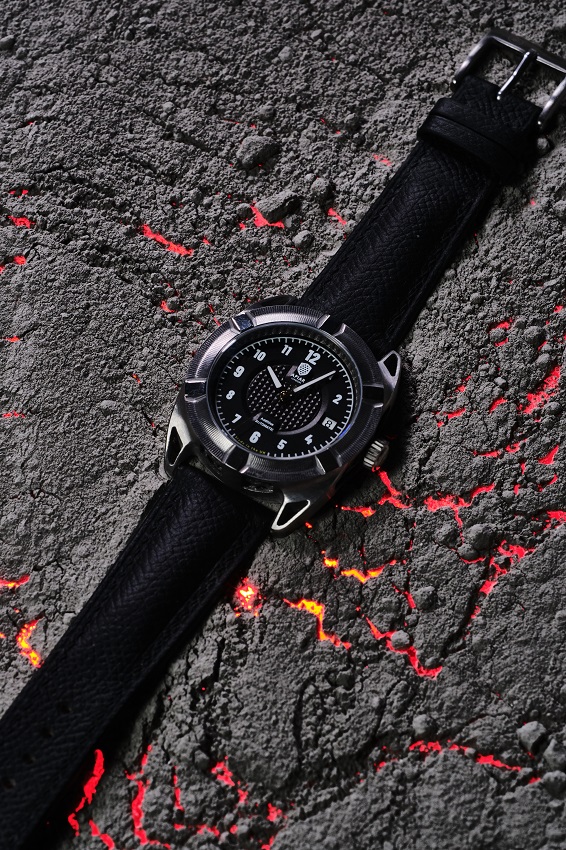
Apiar Invenir v1.0, photo – Apiar, credit realwatchbrothers
If you want to get involved, each watch is fully configurable when ordering via the Apiar website, with the customisable options meaning there are around 180 individual combinations before taking watch straps into account. So, there is a relatively high likelihood of each order being a piece unique, too.
With a few hidden Easter eggs (for example the orange colour for the straps coming from the rev counter of a 1973 Porsche 911 that Sam and his father had restored together as Sam grew up; or the “Henry Black” name referencing Henry Ford’s famous quote “Any customer can have a car painted any colour that he wants, so long as it’s black”) I feel like there is a real personal touch with Apiar, too.
If you have any questions, please get in touch via our Contact page, or via our Instagram.
You might also be interested in:
- Watch Finishing Techniques
- Watch Movement Types Explained
- Independent Watchmaking – An Ode to the Indies
- Watch Stationery and Gift Ideas
- Watch Books, Watch Boxes and more at the Watch Affinity Shop on Amazon (commissions earned)
As an Amazon Associate, I earn from qualifying purchases – thank you for your support

